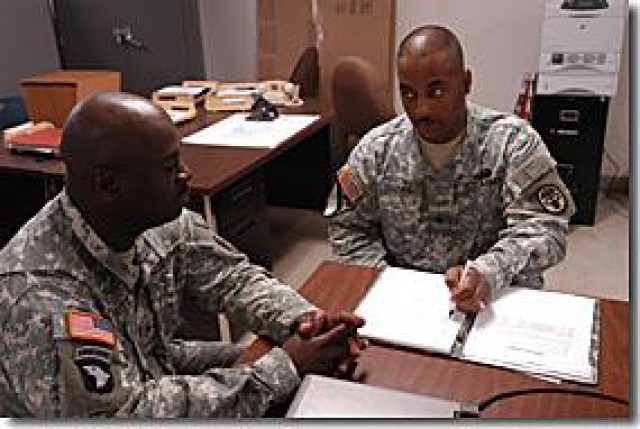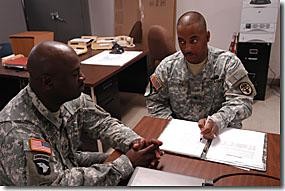Neither deployment, Hurricane Rita nor major surgery has deterred Spc. Sean Gaines from Army service.
To watch Gaines around post, walking tall and briskly makes it difficult to believe that last year he had several cervical discs in his spine replaced.
His recovery enabled him to leave the Fort Campbell Warrior Transition Unit and return to a rear detachment of his old unit, 1st Squadron, 75th Cavalry Regiment, 2nd Brigade Combat Team. Though he can't scout anymore, Gaines is determined to get reclassified as a transportation coordinator and complete his career as a Soldier.
"If I can't be in the fight, at least I can help make sure (Soldiers) get what they need," Gaines said.
As his life demonstrates, Gaines has plenty of grit. But he credits the WTU cadre and others with helping him adjust his skills and mind-set.
"The (WTU) allows you to realize that some things you can't carry on your own," Gaines said.
Gaines came to Fort Campbell because a hurricane stole his hometown. It was September 2005, the end of a yearlong deployment to Iraq. He was thrilled to be reunited with his wife and five children in Lake Charles, La.
Four days later, the Gaineses were fleeing for their lives. Hurricane Rita, a Category 3 storm that pounded the Louisiana and Texas coasts less than a month after Hurricane Katrina, forced the evacuation of many communities.
As soon as Gaines' unit at Fort Polk in Leesville, La., was demobilized, his wife picked him up in the minivan and the family began its escape along with millions of other Louisiana residents. Traffic bogged down Southern highways so much it took 16 hours for the Gaineses to reach Jackson, Miss., normally a four hour trip.
When Rita finally passed, the family was forced to stay at the hotel for two months. Their Lake Charles home was destroyed with the three oak trees in the front yard face down. The community was so unrecognizable that Gaines decided there was nothing to go back to. When he reenlisted in 2006, he requested to be stationed at Fort Campbell.
Gaines first felt the numbness on his left side in January 2007 as he was preparing for his second deployment with the 1-75 Cavalry. A MRI scan revealed that four to seven discs in his back had been damaged beyond repair. Gaines was sent to a veteran's hospital in Georgia and had the discs replaced with cadaver bone.
Gaines reported to the Fort Campbell WTU in Oct. 2007. Not only was he out of action, but he had to watch his 1-75th Cavalry deploy without him.
It was an emotional pit.
"The saddest part is that you know you have the knowledge in your head and the drive in your heart to deploy but your body can't cooperate," Gaines said.
He had heard a about the mission of WTU to help promote the timely return to the force or transition to civilian life but was "afraid he was being put out to pasture."
That fear was quickly laid to rest. As Gaines underwent intensive physical therapy, his nurse case manager guided him in planning his recovery period.
Gaines learned he could take free college classes. He earned 18 credits toward an associate's degree in logistics management.
As his body regained function and his resume began to see a light at the end of the tunnel. He could apply for reclassification and still play a vital part of the mission.
As Gaines became a believer in WTU, he spread the enthusiasm.
Pvt. Mark Puhl remembers Gaines as one of the first ones to welcome him after an eye injury put him out of action in April 2008.
"He just came right up to me, introduced himself and asked what happened," Puhl said.
Several times, Gaines offered to give Puhl, who cannot drive, a lift to the barracks.
Gaines said he tries to encourage other WTU Soldiers to take advantage of the opportunities.
"There is no reason not to," Gaines said.


Social Sharing